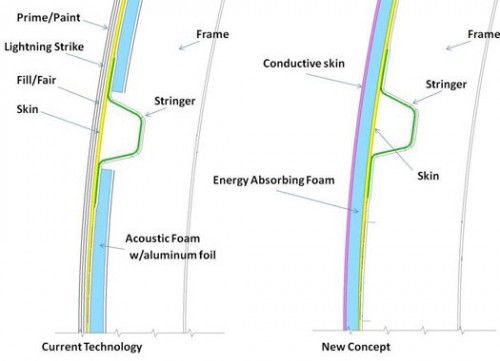NASA’s “Magic Skin” for Airplanes Could Improve Building Envelope Tech
NASA certainly thinks so, and to that end they have awarded four research groups a cool $16.5 million* to make airplanes run more efficiently, quietly, and less dangerously than ever before. One of the groups is a Cessna and GE team, and they are developing a “Smoothing, Thermal, Absorbing, Reflective, Conductive, Cosmetic” skin for planes. The self-healing skin, which has been dubbed STAR-C2 for short, protects metal tubes with wings against a host of horrible threats like impact damage, lightning strikes, electromagnetic interference (EMI), temperature extremes, and it insulates the cabin from noise (Dillow). If you’re like me, you wouldn’t be surprised to learn that STAR-C2 also makes a delightful coq au vin and regularly vacuums the drapes without anybody asking. (Okay, I made up that last part, but that would be nice, wouldn’t it?)
Image courtesy http://ivanovict89.wordpress.com
The research team is working on technology that would make its way into airplanes three generations from now (equivalent to about 25-30 years). It will be worth the weight: “in the final report on its original N+3 study, the GE/Cessna team calculated that the new outer skin made from conductive film and energy-absorbing foam would more than halve the weight of the various measures that now must be taken to protect composite materials from environmental hazards” (Warwick). The material would be self-healing if punctured or torn, but it would also be designed to show damage so that any problems would become apparent to trained inspectors on the ground.
Image courtesy popsci.com
I don’t think the researchers should stop at airplanes. I want to clad entire buildings in this stuff! I don’t see a single benefit that wouldn’t make a building function better, and we have nearly three decades to figure out how to bring the cost of manufacturing it down to something reasonable. I’m excited!
I am filing STAR-C2 under metal and wood, because it enjoys properties of both elements.
*This is a reference to the following passage in Great Expectations by Charles Dickens, which for some reason stuck in my head when I read it in 9th grade:
“I never discovered from whom Joe derived the conventional temperature of the four thousand pounds; but it appeared to make the sum of money more to him, and he had a manifest relish in insisting on its being cool.”
Cited:
Dillow, Clay. “NASA Wants Airliners Wrapped in Self-Healing, Lightning-proof, Interference-repelling ‘Magic Skin'” Popsci.com. 4/7/11. Accessed 4/7/11. URL.
Warwick, Graham. “Cessna to Study Magic Skin for NASA.” Aviationweek.com. 4/5/11. Accessed 4/7/11. URL.


















Leave a Wordpress Comment: